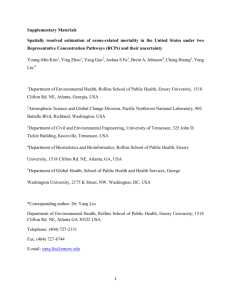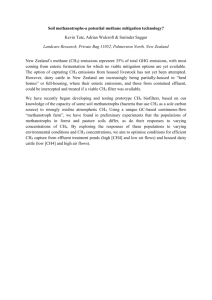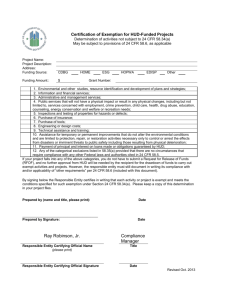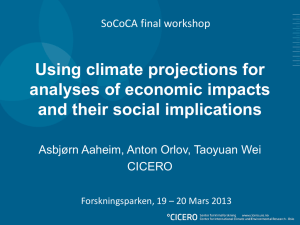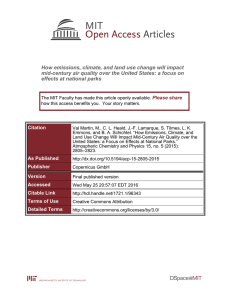Fiore_AAAS
advertisement
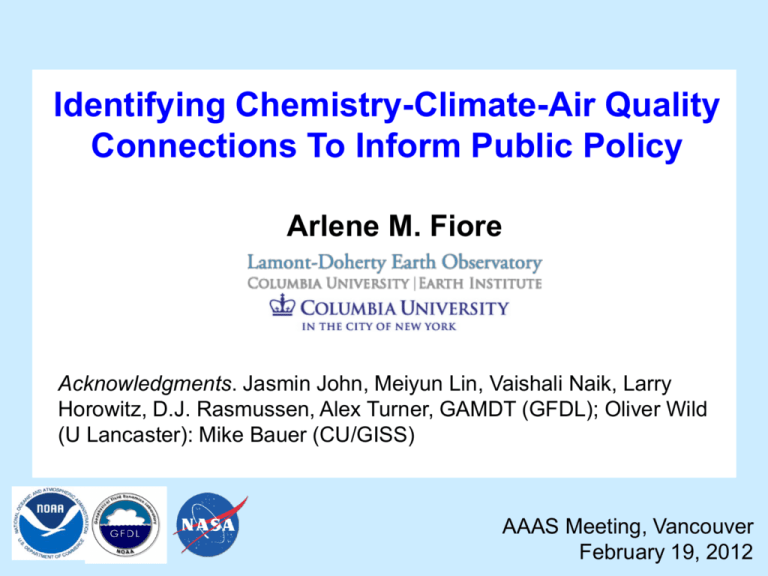
Identifying Chemistry-Climate-Air Quality Connections To Inform Public Policy Arlene M. Fiore Acknowledgments. Jasmin John, Meiyun Lin, Vaishali Naik, Larry Horowitz, D.J. Rasmussen, Alex Turner, GAMDT (GFDL); Oliver Wild (U Lancaster): Mike Bauer (CU/GISS) AAAS Meeting, Vancouver February 19, 2012 Addressing air quality and climate via methane emission controls: A viable option? Ozone reduction (ppb) Cost-saving reductions 0.7 North America Rest of Annex I Rest of World (industrialized nations) 1.4 <$10 / ton CO2 eq. All identified reductions 00 1.9 10% of anth. emissions 20% of anth. emissions 20 40 60 80 100 120 20 40 60 80 100 120 -1 Methane Methanereduction reductionpotential potential(Mton (MtonCH CH4 4yryr)-1) IEA [2003] for 5 industrial sectors ~25% of global anthrop. emissions at cost-savings / low-cost >1 ppb decrease in global surface ozone West & Fiore, ES&T, 2005; Fiore et al., GRL, 2002 Benefits of ~25% decrease in global anthrop. CH4 emissions OZONE AIR QUALITY CLIMATE Global mean avoided warming in 2050 (°C) Range over 18 models ~ 1 ppb, robust across models (factor of 2 range) [Fiore et al., JGR, 2009; TF HTAP, 2007, 2010; Wild et al., ACPD, 2012] 7700-400,000 annual avoided cardiopulmonary premature mortalities in the N. Hemisphere uncertainty in concentration-response relationship only [Casper Anenberg et al., ES&T, 2009] [WMO/UNEP, 2011] Atmospheric CH4 and surface O3 over the next century? Representative Concentration Pathways (RCPs) ppb METHANE RCP8.5 RCP6.0 RCP4.5 RCP2.6 Tool: GFDL CM3 chemistryclimate model • ~2°x2°; 48 levels • Atm-ocean-sea ice-land GCM • Fully coupled chemistry in troposphere+stratosphere • Aerosol – warm cloud interactions c/o V. Naik NOx Emissions RCP4.5* WMGG Tg N yr-1 RCP8.5 RCP4.5 c/o J. John Donner et al., J. Climate, 2011; Golaz et al., J. Climate, 2011; Naik et al., in prep, Horowitz et al., in prep Multiple feedbacks complicate projections of atmospheric CH4 and O3 abundances tCH Stratospheric O3 Troposphere BCH 4 = tropopause 4 k (T )[OH ][CH ] 4 surface NOx O3 + hν O1D + H2 O OH + CH4 k CH3+H2O T T NOx, CO, NMVOC, CH4 Anthropogenic sources Biospheric sources Negative feedback of warming climate on methane lifetime; anthrop. emission trajectory can amplify or counteract TROPOSPHERIC CH4 LIFETIME IN GFDL CM3 CHEMISTRY-CLIMATE MODEL t Years RCP 8.5: CH4: +4%: Doubling CH4 offsets influence of warmer T (+4.5K) RCP4.5* WMGG only: t RCP4.5: CH4: -13% More warming (+2.3K; aerosol), CO, CH4 decrease J. John et al., in prep tCH : -5% 4 Rising T(+1.4K), OH (LNOx, H2O) Percentage changes are (2081-2100) – (20062025) How will O3 air quality evolve over North America? RCP emissions: lower? Warmer climate: higher? Dramatic rise in CH4 in RCP8.5 opposes NOx-driven decreases Observed O3-T correlation implies that changes in climate will influence air quality July mean obs from U.S. EPA CASTNet site Penn State, PA 41N, 78W, 378m TEMP (C; 10am-5pm avg) [Wild et al., revised for ACP] MDA8 O3 (ppb) Annual mean N. Amer. Surface O3 changes (ppb) NO CLIMATE CHANGE O3 change estimated from sensitivities derived from TF HTAP model ensemble Over NE USA, stagnation episodes are a major driver of observed surface O3-T correlation: Future evolution? Leibensperger et al. [2008]: strong anticorrelation in summer between (a) number of migratory cyclones over Southern Canada/NE U.S. and (b) number of stagnation events and associated NE US high-O3 events Number of storms in region each summer (JJA) in RCP8.5, GFDL CM3 model Robust across models? [e.g., Lang and Waugh, 2011] Can we evaluate modeled relationships btw air quality and climate? Cylones diagnosed from 6-hourly SLP with MCMS software from Mike Bauer, (Columbia U/GISS) æ ç -4 è é exceedances ùö æ ê ú÷ × ç -6 ë cyclone ûø è é cyclones ùö êë úû÷ = +24 summer ø é exceedances ù êë ú summer û A. Turner et al., in prep How well does a global chemistry-climate model simulate regional O3-temperature relationships? “Climatological” O3-T relationships: Monthly means of daily max T and monthly means of MDA8 O3 AM3: 1981-2000 OBS: 1988-2009 r2=0.41, m=3.9 r2=0.28, m=3.7 July Monthly avg. daily max T Slopes (ppb O3 K-1) July Monthly avg. MDA8 O3 CASTNet sites, NORTHEAST USA Month Model captures observed O3-T relationship in NE USA in July, despite high O3 bias Broadly represents seasonal cycle Rasmussen et al., Atmos. Environ., 2012 What is the combined impact of climate + emission on surface O3 over North America? Annual mean N. American surface O3 change (ppb) EMISSIONS CHANGE ONLY EMISSIONS + CLIMATE CHANGE 520 GFDL CM3 RCP8.5 RCP4.5 ens. mean Individual members 015 -510 [Wild et al., revised for ACP] -10 5 2005 2025 2045 2065 2085 Why does O3 increase in GFDL CM3 RCP8.5? Higher CH4 sensitivity? Increased strat O3 influence? [e.g., Butchart et al., 2006; Hegglin & Shepherd, 2009; Kawase et al., 2011; Li et al., 2008; Shindell et al. 2006; Zeng et al., 2010] How well do models represent strat-to-trop O3 transport? Western NA: Particularly active region for STE in present day, a good test case for model evaluation Upper level dynamics associated with a deep stratospheric ozone intrusion (21:00UTC May 27, 2010) Satellite observations AM3 “nudged high-res” (~50km2 ) 250 hPa simulations potential vorticity AIRS total column ozone DU GOES-West water vapor 250 hPa jet (color) 350 hPa geopotential height (contour) Decreasing humidity AM3 resolves features consistently with satellite perspective M. Lin et al., in prep. Identifying chemistry-climate-air quality connections to inform public policy… some final thoughts • Methane controls as “win-win” for climate and O3 air quality Cooling influence on climate (by lowering both methane and O3) Decrease baseline surface O3 (robust across models) Complex chemistry-climate feedbacks along future trajectories • Analysis of long-term chemical and meteorological obs may reveal key connections between climate and air pollution Crucial for testing models used to project future changes Need to maintain long-term observational networks • Climate-driven influences on air quality Need better process understanding at regional scale; new opportunities with chemistry-climate models Potential for shifts in relative importance of locally produced vs. transported O3

